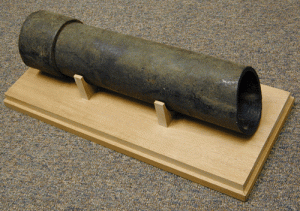Midcentury modern homes are hot right now, but they may come with a ticking timebomb – Orangeburg sewer lines.
I’ve Never Heard of It!

Orangeburg was a brand name for a cheaper alternative to traditional metal pipes popular in the 1950s-1960s. Instead of cast iron that would last generations, builders chose to mix wood pulp with pitch to make a perfectly serviceable pipe to connect new homes to the city sewer system. Builders saved a ton of money. The first homeowners would have experienced no problems. However, as you might imagine, “a coal tar-impregnated toilet paper tube” doesn’t stand up to the decades. Its archnemesis: tree roots. They will bore right through an Orangeburg pipe or wrap roots around the pipe, crushing it (because trees love fertilizer – even sewer waste!). When this happens, you have a mess in your front yard – one you may not even realize is there. Nobody wants raw sewage leaking out into your front lawn.
By the 1970s, PVC pipe came along and Orangeburg went the way of history. The Orangeburg company shuttered its doors in 1972.
Does My Home Have Orangeburg?
If your home was built in the mid 1970s or later, you are probably in the clear. Most homes with Orangeburg were built in the 1950s and 1960s, although there are some outliers. You can check building permits with the city to see what information they have about sewer permits and replacements, but it probably won’t be conclusive.
Your real estate agent may be able to find out if previous homeowners did an Orangeburg inspection when they purchased the house.
Your only sure bets are to either snake a camera into the sewer lines to inspect the pipe, or dig up the yard to inspect the pipe. You can probably guess which one I recommend to my homeowners!
The cost to inspect for Orangeburg is reasonable, but the cost of repair/replacement can be substantial.
My Home Has Orangeburg… Now What?
Maybe nothing! If the camera shows that the pipes are holding up, then you can choose to take a “wait and see” approach, although most homeowners choose to replace the Orangeburg. Orangeburg will almost certainly fail, given enough time.
If the inspection shows that the Orangeburg pipes are failing, you are in for a project. You will need to choose a contractor (I can direct you to contractors I have succcessfully used in the past, even if you didn’t purchase your home with me). They will dig a large, deep trench in your front yard from about five feet from your foundation to the city sewer lines. They will expose, remove and replace the Orangeburg with the product of your choice (typically PVC pipe). Then, they’ll fill in the hole and you’ll have to sod/seed the fresh soil.
I Want to Purchase a Midcentury Home
Unless the homeowner can demonstrate that Orangeburg has been replaced, I recommend that my clients make any purchase offers contingent upon a sewer inspection with video, and the replacement of any Orangeburg lines, whether they are currently failing or not. I am happy to help my clients navigate the entire process, and have had great results, unlike this story of an unrepresented Cedar Rapids buyer who got stuck with the bill to replace Orangeburg because she didn’t ask the right questions about the property disclosure.
Further Reading
If you want to learn more, I’d recommend the amazingly specific site Sewer History: http://www.sewerhistory.org/articles/compon/orangeburg/orangeburg.htm
Here’s what the city of Cedar Rapids has to say about Orangeburg: http://www.cedar-rapids.org/local_government/departments_g_-_v/public_works/frequently_asked_questions.php
*This is the first article in a series about home inspections. Stay tuned!

[…] in a series about home inspections. If you missed it, please go back and read the post on Orangeburg pipes. Stay tuned for more home inspection […]
LikeLike
[…] about home inspections. If you’re just tuning in, please go back and read the posts on Orangeburg pipes and Radon gas. Stay tuned for more home inspection […]
LikeLike